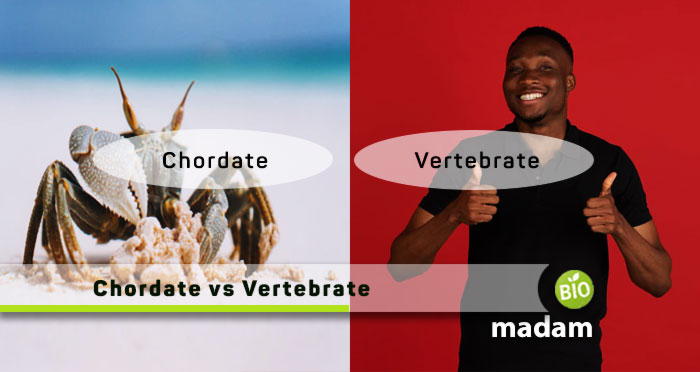Chordates and vertebrates belong to the kingdom Animalia and comprise eukaryotic cells. They are heterotrophic organisms like other animals and act as consumers in the food chain and food webs. Despite many similarities, there are a few differences between chordates and vertebrates. Essentially, chordates belong to Phylum Chordata, while vertebrates are a further division within phylum Chordata. Thus, we can say that all vertebrates are chordates, but all chordates are not vertebrates.
Keep reading to learn all the differences between chordates and vertebrates.
Comparison Table
| Characteristics | Chordates | Vertebrates |
| Definition | Presence of notochord | Presence of vertebral column |
| Types | Tunicates, vertebrates, and cephalochordates | Aves, mammalia, reptilia, amphibia, osteichthyes |
| Skeletal System | Notochord and cartilaginous material | Exoskeleton and endoskeleton |
| Muscular System | Unsegmented muscles | Epithelial and connective tissues |
| Nervous System | Brain-like structure at the anterior end | Brain, nerves, and spinal cord |
| Circulatory System | Blood pumps by heart and vessels | Three or four chambered heart |
| Respiratory System | Gills | Lungs, gills, or body surface |
| Digestive System | Filter feeding system | Distinct GI tract |
| Excretory System | Kidneys and gills | Kidneys |
What are Chordates?
Chordates are organisms that makeup the phylum Chordata of the kingdom Animalia. Chordates have a bilateral body and are deuterostomes in nature. Some of them live in the sea, whereas a few live in sand throughout their lives. A few other classes actively participate in food webs in various habitats and ecosystems.

Structure of Chordates
Chordates possess a dorsal central nervous system, a notochord, pharyngeal gill slits, and a tail.
The notochord is a cartilage rod extending through the body, while the dorsal nervous system acts as the central nervous system. The dorsal tube connects to the peripheral nervous system. The pharyngeal gills in chordates are behind the mouth and help filter the ingested material.
Types of Chordates
Phylum Chordata is categorized into three sub-phyla: cephalochordata, tunicates, and vertebrates. Let’s tell you the characteristics of each.
Tunicate
Tunicates are also known as urochordates. The adult body is enclosed in an entity made of a cellulose-like substance called “tunicin.” They possess notochord in the larval stage and are not present in adults. Similarly, the nerve cord present in larvae is replaced by a dorsal ganglion in adults.
Cephalochordate
Cephalochordates have a motile larval and adult stage and a tail throughout their life. They exhibit progressive metamorphosis. Members of cephalochordata have an atrium, notochord, and well-developed pharyngeal gill slits.
Vertebrates
Vertebrates are the third class of chordates and possess a higher degree of cephalization. They have a complete alimentary canal besides a three or four-chambered heart. They also have exocrine and endocrine glands, and a well-developed nervous system, including sympathetic and parasympathetic. Besides, their respiratory and excretory systems are also fully grown.
Keep reading to know more about vertebrates.
What are Vertebrates?
Vertebrates are animals with a vertebrate or spinal cord and notochord during some point in their life.
Vertebrates and invertebrates have a common ancestor that lived on Earth around 600 million years ago. True vertebrates evolved almost 525 million years back.

Structure of Vertebrates
All vertebrates have a vertebral column running through the length of the organism. A few vertebrates may also have a notochord while the notochord develops into a vertebral column. The nerves arise from the vertebral column and the brain. The mouth is found on the anterior side or below it. The alimentary canal comprising esophagus, stomach, small and large intestine ends at the anus on the exterior side.
Types of Vertebrates
Vertebrates are classified into five classes based on the similarities and differences between organisms. Here are the types of vertebrates:
Class Mammalia
Mammals are warm-blooded animals and have the ability to regulate their body temperature. They give birth to their young ones, which feed on the milk produced by the mother’s mammary glands. They are a part of almost all types of biodiversity.
Examples of mammals include humans and elephants.
Class Reptilia
The members of the reptilian class are ectothermic. They have rough, scaly skin without any glands present. They have a three-chambered heart, and respire through the lungs.
Examples of reptiles include alligators and snakes.
Class Amphibia
Amphibians are characterized by their slimy body and the need for water for breeding. Their larvae undergo metamorphosis to develop into adults from larval form.
Examples of amphibians are toads and frogs.
Class Aves
Class Aves comprises birds of different kinds. They have toothless beaks and feathers on their body. They lay eggs with shells as opposed to other classes. Birds contribute to terrestrial communities and ecosystems besides their time in the sky.
Birds include ostriches and pigeons.
Class Osteichthyes
This class consists of bony fishes that have a proper bony skeleton. It is the largest class of vertebrates known to science for now.
The most widely known examples of bony fish are sharks.
Class Chondrichthyes
This class is also known as the class of cartilaginous fish. Chondrichthyes comprise fishes that have a cartilaginous skeleton instead of a bony skeleton. They are thought to have existed for at least 273 years.
Examples of Chondrichthyes include ray fish and sawfish.
Class Agnatha
Class Agnatha is the seventh class of vertebrates. It comprises primitive fishes that do not have a jaw in their mouth. They have not evolved much and have a circular mouth to hold and feed on other fish. Some fishes in this class are parasites.

Similarities between Chordates and Vertebrates
- Chordates and vertebrates have a notochord post-anal tail and pharyngeal gill slits.
- Both of them are deuterostomes, and not protostomes.
- They possess a nervous system.
Differences between Chordates and Vertebrates
Definition
Chordates
Chordates are organisms that make up the phylum Chordata. They possess a bilateral body and are deuterostomes in nature.
Vertebrates
Vertebrates are animals belonging to subphylum vertebrata. They have a vertebrate or spinal cord and notochord at some point in life.
Sub-Division
Chordates
Tunicates, cephalochordates, and vertebrates are the subphyla of phylum Chordata.
Vertebrates
Vertebrates are further categorized into seven further classes, including aves, mammalia, reptilia, amphibia, osteichthyes, chondrichthyes, and agnatha.
Structure
Chordates
Chordates possess a dorsal central nervous system, a notochord, pharyngeal gill slits, and a tail.
Vertebrates
All vertebrates have a vertebral column running through the length of the organism. A few vertebrates may also have a notochord while the notochord develops into a vertebral column.
Skeletal System
Chordates
The notochord in the skeletal system of chordates keeps the animal from losing its shape in the presence of locomotory waves. The skeleton also has cartilaginous material that supports the gills and other body components.
Vertebrates
Vertebrates receive support from the exoskeleton and endoskeleton. The exoskeleton protects the body but may also offer other functions, like teeth in the buccal cavity. The endoskeleton acts as a protection for the spinal cord and brain and facilitates locomotion. It may be in the form of spongy bones, compact bones, and cartilage.
Muscular System
Chordates
The muscles are an important component of chordates. They are well-developed and segmented in vertebrates and cephalochordates. However, the muscles in the tales do not show segmentation.
Vertebrates
Vertebrates, such as humans, have a tough, muscular system made of tissues that extend throughout the body. Epithelial and connective tissues together make the lining of different organs and provide support in movement. Different types of epithelial tissues form the lining of the respiratory, gastrointestinal, and reproductive tracts. Alternatively, connective tissues give rise to tendons and ligaments.
Nervous System
Chordates
While all chordates have a brain-like structure at the anterior end of the main nerve cord, only vertebrates have a fully-developed brain.
Vertebrates
The nervous system comprises the brain, spinal cord, and nerves. The vertebral nervous system has two main divisions: CNS and PNS. These are further categorized into the autonomic and somatic nervous systems.
Circulatory System
Chordates
Cephalochordates’ circulatory system is based on the contraction of blood vessels, while tunicates and vertebrates possess a heart to pump blood. Unoxygenated blood is sent forward through the ventral aorta. It passes through the branchial arteries in the gills, and gas exchange occurs. The oxygenated blood reaches the body parts, and some of it returns to the dorsal aorta.
Vertebrates
The circulatory system comprises fluids enclosed in vessels, so the cells can travel in and out of the blood vessels. The blood contains red blood cells and white blood cells. The white blood cells comprise different antibodies that make up body immunity.
Respiratory System
Chordates
Tunicates and cephalochordates use chordate gills to facilitate respiration However, the gills became reduced with evolution.
Vertebrates
Respiration in vertebrates involves specialized structures like gills or lungs. Sometimes respiration may take place through the skin as well. It facilitates the exchange of gasses between the environment and the body tissues.
Digestive System
Chordates
The members of tunicates and cephalochordates subphyla of Phylum Chordata feed on small particles of food through filter feeding. Jawless fish called the lamprey exhibit a similar pattern in the larva stage despite belonging to vertebrates.
Vertebrates
The digestive system of vertebrates has a distinct structure. They have a segmented stomach followed by small intestine and large intestines. The food from the mouth travels to the stomach through the digestive tube.
Excretory System
Chordates
The excretion of waste is controlled by kidneys in members of Chordata, while gills also play a major role. Kidneys also manage the chemical composition of the internal environment.
Vertebrates
The excretory system is unique as the nephrons filter the blood and remove the toxins. In some vertebrates, like sharks, urea raises the osmotic pressure of blood. It helps them excrete without using a lot of energy.
The Bottom Line
Vertebrates and chordates are similar to each other significantly. The most significant difference between these phyla is their classification order. Vertebrates are a subphylum of Phylum Chordata. Other sub-divisions of the phylum include tunicates and cephalochordates. Chordates have a notochord, while the notochord in vertebrates may or may not develop into the vertebral column. Vertebrates include birds, mammals, reptiles, and amphibians. Vertebrates are evolved chordates and have more specialized organ systems than chordates.
FAQs
What is the difference between vertebrates and invertebrate chordates?
Invertebrates in the phylum Chordata have a notochord. However, vertebrate chordates have a spinal cord or vertebrae instead of the notochord. All chordates have a defining rod-like structure in their back, though.
Are chordates considered vertebrates?
Vertebrates are one type of Chordata, and humans are the most common example of vertebrate chordates. Other vertebrates include birds, reptiles, amphibians, mammals, and fishes.
What do all chordates not have?
While all chordates have a notochord in their initial stage of life, some might not have it in the adult stage. Tunicates do not have the notochord in their adult stage, whereas vertebrates have a spinal cord instead of the notochord.
What 3 things do all chordates have?
Three main features are present in all (vertebrates and invertebrates identify all Chordates) at some point in their life. They include a dorsal hollow nerve cord, a notochord, and pharyngeal slits.

Hello, I would like to introduce myself to you! I am Chelsea Rogers, an experienced blog writer for science articles, holding an MPhil degree. My enthusiasm to grab the best knowledge, let it relate to botany, zoology, or any other science branch. Read my articles & let me wait for your words s in the comment section.

